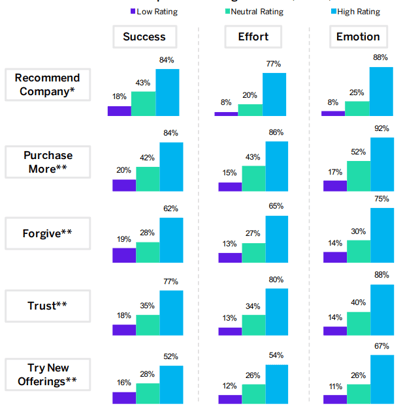We've all heard those amazing emotional customer experience stories that leave us speechless. While they jolt the emotions and create a sense of amazement for the brand, they frequently wind up attracting attention since they are so out of the ordinary. They aren't the usual circumstances in which the brands operate.
When brands walk an extra mile to connect with their customers emotionally, that will rewrite their customer experience journey forever!!
The customer experience provided by the Opryland Hotel, which is, by the way, not a popular household name, but yet is a fantastic example of a great customer experience.
When a writer visited Nashville for a conference, she found the clock radio in her hotel room at the Opryland to be one of the best, most calming things she'd ever used.
The writer was so taken with it that at the end of her stay, she inquired about the radio's make and model in order to purchase one for herself.
Unfortunately, the radio was developed specifically for the hotel. It wasn't for sale elsewhere, and the Opryland representative who spoke with the author confirmed this. They did guide her in the direction of a Sharper Image model that was similar but didn't have the spa sounds.
When the writer returned to pack things later, she discovered a radio waiting for her, along with a note indicating that it was hers to keep.
This customer experience example demonstrates how something as insignificant to your organization as a clock radio or a gift card can have a significant impact and meaning for your consumers.
This simple but valuable gift from Opryland Hotel connected the customer emotionally.
Here, this ‘emotional connectivity’ has more value than ‘satisfaction.’ This makes the customers loyal and sticks to the brand no matter what other options are available for them.
It's All About the Human to Human Connection

Human emotion changes based on the situations and scenarios they go through. A buying journey consists of different actions; various emotions trigger all these actions.
There are positive and negative emotions; positive emotions include 'happiness,' 'joy,' 'excitement,' 'satisfaction', 'gratitude,' and so on. On the flip side, negative emotions are 'sad', 'angry,' 'frustration,' 'disappointment', etc.
Studies found that negative emotions will stay longer in a human's mind than positive emotions. That is the reason why customers do not return to brands when they have a terrible experience with their products or services.
Brands should connect with their customers as 'humans' rather than consider them as 'customers' or ‘prospects’ or ‘wallets’. If you treat them with the human touch and personalized informal and friendly messages, they can connect seamlessly.
Negative emotions like sadness and fear will help customers to connect easily.
For example, the World Wildlife Fund used commercials featuring natural disasters, climate changes, and endangered animals. This creates fear and sad emotion in people, and they would join the team to work to preserve wildlife.
Emotionally connected customers will add more value to a business than just satisfied customers.
Emotion Opens Up the Way to Customer Loyalty
Customer experience is a combination of Success, Effort, and Emotion. All three aspects are essential to generating customer loyalty. But, only elevated emotional connectivity can contribute long term customer loyalty.
Studies revealed that there are five loyalty behaviors of customers. They are - Recommend company, Purchase more, Forgive, Trust and Try new offerings.
When we check these loyalty behaviors against how the three aspects - Success, Effort, and Emotion affect them, it is found that ‘Emotion’ stimulates more of this loyalty behavior.

(Source: ROI of Customer Experience)
If a customer experienced positive emotions, they would recommend that brand to their friends and family and trust them. Moreover, they will also forgive occasional mistakes from the brand’s side like they forgive people in real life. This proves that ‘Emotion’ can drive the customer experience to the next level.
The Combination of Emotional and Rational

For any customer action, there will be a feeling that triggered them to do that. These drivers are called 'Emotional Motivators.' Brands have to find the emotional motivators in their customers to like or dislike their products rather than solely focusing on rational elements.
Rational factors are essential to running a successful business, but it won't sustain long term unless there is an emotional factor. Customers consider reasonable or rational factors when choosing a brand like: Can I get better brands than this, or are there brands that offer the same products at lower prices, etc. Resonating this in the marketing will help brands to attract new customers. Like, if they advertise, they are the best brand in the market that offers the lowest price, maximum offers, etc.
But, connecting emotionally is necessary to build a pack of loyal customers. If a brand resonates with the value that a customer is looking for and can elicit positive emotion with their product and services, they will come to that brand again. They won't think about whether there are better products in the market. They want their favorite brand, which cares about them and understands their values.
For example, think about why people go to that favorite retail store whenever they pass by other retail stores near their home? Why do Apple customers buy Apple over and over? See, we are emotionally connected to some brands or companies unknowingly. Because they offer what we want and understand our emotions, and act upon them.
Here, people do not even want to know the offer other retailers provide, or even if they do, they don't care about it because they are emotionally connected to that store. There can be many reasons for this, as the staff in the store are very friendly, or the billing person renews the membership of the regular customers on time even before the customer requests to do that.
Customer’s Expectation Level is the Benchmark

When a customer does a business with a brand, an expectation level will automatically form in their mind. If the experience they got from the purchase exceeded the expectation, it creates positive emotion; if it disappoints the customer, a negative emotion will be formed.
For example, when a person went to a coffee shop three blocks away from their office, it started to downpour unexpectedly. When he asked the barista where he could find a store to buy an umbrella, the barista said it was one block away from the coffee shop. Since it was raining heavily, he could not go to the store. Understanding his situation, the barista gave his umbrella to the customer and said, “You can use my umbrella to go to the store.” He went to the shop, bought a new umbrella, returned the barista’s umbrella, and said thanks.
This simple action of the barista made the customer become a regular, moreover loyal customer of that coffee shop henceforth. Even though the barista found a job in another coffee shop in some other town, this customer never stopped going to that coffee shop. That’s the emotion he gets from the shop that drives him to go there repeatedly. Here the emotion experienced was gratitude, comfortability, and the feeling of value. All these are a form of joy or happiness, overall a positive experience.
Take another example, when a person ordered a toy from an online store days before his son’s birthday, the package did not arrive on the expected date. When he tried to contact the customer care team of the store, they had no idea what had happened to the shipment. The customer did not receive any status mail from the company, and the staff could not track the shipment. What could be the emotion of the customer here?
Surely it will be ‘frustration,’ ‘anger,’ and ‘disappointment.’ Even though they received the toy after two days and his son loved it, the customer never considered the toy store anymore. The disappointment and frustration in his mind remained the same, although they liked the products.
In the first example, the customer got an experience that exceeded the expectation and got emotionally connected with the brand. In the second example, the brand went below the expectation of customers, and it created negative emotions.
How to Capture Customer Emotion?
To recognize customers’ emotional connection with a brand, gathering and evaluating both structured and unstructured data from customer interactions is essential. Brands can fetch solicited data through various satisfaction surveys and request and response methods through social media channels to gather emotions from customers directly.
The requestor direct questions you can ask your customers to understand their emotional connection can be:
-
When have you recently experienced a positive/negative experience in interaction with the brand?
-
What was your feeling after finishing a specific interaction with us?
-
What is the level of a particular emotion (positive/negative) you feel when you think about our brand, product, or service?
-
What do you think about our latest product/service?
Brands need to capture the unstructured or unsolicited data through customer reviews on third-party platforms, customer support tickets, live chat conversations, social mentions, social forums, etc.
Analyzing the combination of these data will help brands understand customer emotions at different points of their purchase journey. To effectively use these data to gather insights, brands can also use robust third-party tools.
Analyzing the data in detail will help to scrutinize the customer's emotions. But, we cannot precisely perceive customer emotion from unstructured data. For that, brands need to use sentiment analysis and text analysis tools. These tools will check the customer interactions in detail and extract the emotion and sentiment in the texts.
Simply, if many customers talk about something negative about a feature of your product or they feel frustrated with it and they express it, there is a real problem you need to solve as soon as possible. If you do not solve the problem, you may get a few new customers, but your regular customers will not return to your brand.
For example, Skittles, the candy, once removed many customers’ favorite lime and included green apple instead of lime. Mars has made this grave mistake which made many customers abandon this candy. Customers expressed their concerns through tweets and other social media platforms. Understanding the customer's emotion from these responses, Skittles let lime in and kicked out the green apple. Skittles announced this with an apology tweet - “Lime Skittles are Back! Sorry, we took them away.”
This made the Skittles lovers happy, and they returned to this brand. Taking the appropriate actions by analyzing customer emotions helped them reconnect with their customers emotionally once again!
Customer experience analytics platforms can fetch customer interactions, including reviews on third-party sites, live chat, CRM, etc., and identify the patterns and positive and negative trends in customer experience with AI and ML technology.
Using the information it offers, brands can tune their customer experience strategy accordingly, avoid previous mistakes, and continue and improvise actions that keep customers happy and satisfied as Skittles did.
Transforming the insights gathered from the analytics platform into the right actions is also very important. Hence, emotions should be perceived accurately and implement the right measures that turn negative emotions into positive ones. Doing these practices continuously will polish the experiences into positive, and customers will start feeling positive feelings toward the brand. Consistency in the actions also keeps customers emotionally connected with brands.
With these methods, brands can reduce the churn rate and elevate ‘customer satisfaction’ to ‘emotional connectivity’ in customer experience.
3 Ways to Build Emotional Connection with Customers

Every brand needs to try their best to connect with their customers for them as well as their customers. Every brand is different, and so do its customers and their emotional drivers.
There are three ways brands can build emotional connectivity with their customers.
1. Realizing the Emotional Values of Customers
Brands need to analyze their customer feedback, understand the core value they expect from the brand, and reflect it in their experience. Here, the brands need to understand what customers hope and expect from your brand. Understanding this will help to embody the values in your brand to reflect them in the experience you deliver.
For example, customers expect agile and flawless services in a banking brand since it is all about financial transactions. A bank should understand these expectations from their customers and train their employees to provide solutions quickly without any errors. Here, when the customer expectations meet the brand experience, it forms a feeling of 'trust' in customers' minds. Here, the banking brand should resonate 'trust' in the experience they offer. They have to fine-tune their operational and customer experience practices accordingly.
Small brands with a limited number of customers can understand the core values of each customer in detail and offer a personalized experience to nurture emotional connectivity. But it will be a bit difficult in a large and sophisticated company.
2. Do not Forget the Quality
Consistency in the quality of products and services is a must for any business's success. If customers get quality service and products continuously, they will trust the brand, and even any pricing change in the future will not change the customer's mind to go for any other products.
Also, when any issue happens, the brand should take the responsibility to solve it as soon as possible. Taking ownership to solve the problem and being there for customers will create positive emotional connectivity.
3. Tell Stories to Customers
Telling your success stories and how you reached today will help your customers feel comfortable to open up their customer stories to you. From their stories, you can perceive their emotional motivators and work on them to reflect them in the experience you offer next time. Also, sharing your accomplishments and success stories will let the customers know why they should do business with you.
Final Thoughts
Emotionally connected customers are more than twice as valuable as highly satisfied customers!!
Emotional connectivity with customers is indeed a strength of a brand. Simply satisfying a customer may not contribute to long-term relationships with customers. But emotionally connected customers will be a great asset to a brand in the long term.
To connect with customers on a human level and earn their loyalty, brands need to adapt their personalization and engagement strategies. This requires capturing and analyzing customer reviews which can provide detailed, qualitative information about how your customers are feeling, which can then be utilized to better respond to customer interactions as they occur.
When done right, capturing and understanding customer emotion has the potential to transform the customer experience (CX) journey.


